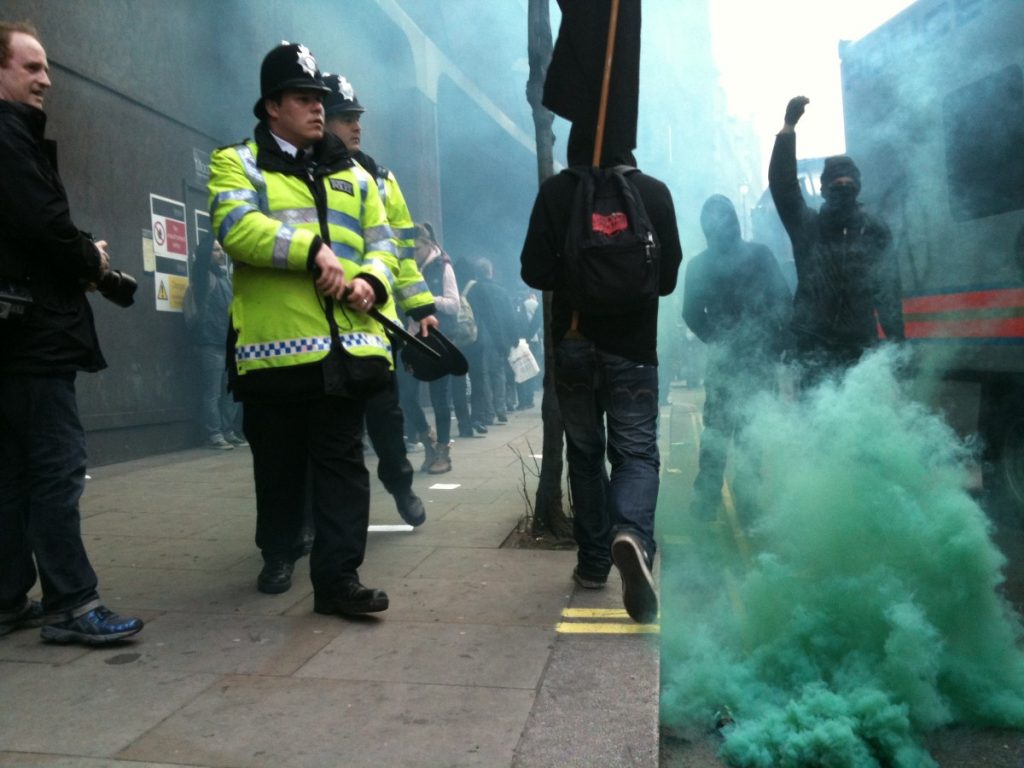Home Office declares war on the anarchists
By Ian Dunt
Violent demonstrators may face “pre-emptive banning orders” and be forced to remove their masks, under plans being considered by the Home Office.
The plans could result in the face-coverings and balaclavas employed by fringe groups at demonstrations being banned during marches.
The home secretary may also expand the use of banning orders currently used against football hooligans to stop known trouble-makers attending protests.


So far, 201 people have been arrested in connection with the disorder on Saturday, when roving gangs of anarchists attacked shops in central London while up to half a million protestors marched peacefully through London.
Some 145 people were charged with aggravated trespass following UK Uncut’s occupation of Fortnum and Mason.
Eyewitness: On the frontline with anarchist demonstrators
Theresa May refused to rule out further actions against anarchist groups, including dawn raids and the use of snatch squads.
“That’s the sort of thing we would see in Tripoli, not London,” former shadow home secretary David Davis complained.
Anti-cuts anarchists smash up London: In pictures
But the government initiative was supported by Labour, who urged “coordinated action to deal with anarchist groups”.
Shadow home secretary Yvette Cooper said: “These incidents have been increasing every time there is a crowd event and people are fed up with it.”
Cross-party unity was shattered when Ms May refused to publically rebuke London Mayor Boris Johnson, however, who wrote in the Telegraph that Labour would be “quietly satisfied” by the violence.
Issue of the day: Protest aftermath
“The sad thing is that in spite of their crocodile tears, [Ed] Balls and [Ed] Miliband will feel quietly satisfied by the disorder – a token, they will tell themselves, of the public feeling that is out there to exploit,” Mr Johnson wrote.
The piece prompted a furious reaction from Labour HQ, with deputy Labour leader Harriet Harman demanding an apology.
Ms Cooper reiterated that demand in the Commons today, as Ms May side-stepped seven requests for a retraction.
“This is typical of Boris Johnson – thoughtless, shallow and plain wrong,” Ms Harman said.
“He should withdraw this disgraceful allegation immediately.”
Ms May replied: “The mayor of London is open to make the remarks he wants to make.”
The Mayor further antagonised trade unions when he said the TUC should help pay for the damages caused by the violent groups.
“Obviously there has been damage to property and it would be a wonderful thing, frankly, if the organisers of the march would contribute to the costs of clearing it up,” he said.
Unions responded angrily to the Mayor’s suggestion.
Dave Prentis, general secretary of Unison, said there was a clear distinction between the violent minority and the TUC march.
“It is therefore ridiculous to suggest that the TUC should pay towards the clean-up operation. Will he ask the Queen and Prince Philip to chip in if there is violence on the royal wedding day?” the union leader said.
Critics have asked why the police were unable to stop the attacks on Saturday, given that they had been tracking activity in the run up to the march.
Met commander Bob Broadhurst said: “Just as police review and change our tactics we saw a deliberate shift in tactics by those small groups to avoid police lines.
“By keeping highly mobile, using small alleyways and cut-throughs and covering their faces, these people appeared to think they could evade police.”
Most observers accepted that there was a very distinct split between the hundreds of thousands of people attending the main rally, the UK Uncut demonstrators who used non-violent tactics to occupy Fortnum and Masons and the black bloc anarchists causing disruption in the West End.
But Ms May also refused to recognise the distinction, saying: “The police are right in what they were doing.
“The people who should be condemned are the people doing that occupation, who were perpetrating acts of violence.”
Those occupying Fortnum and Masons complained that they had been tricked into leaving the shop by police, who told them they could leave without being interrogated.
Once outside, they were corralled into a group, broken up, photographed and arrested. Journalists were moved away from the scene.









